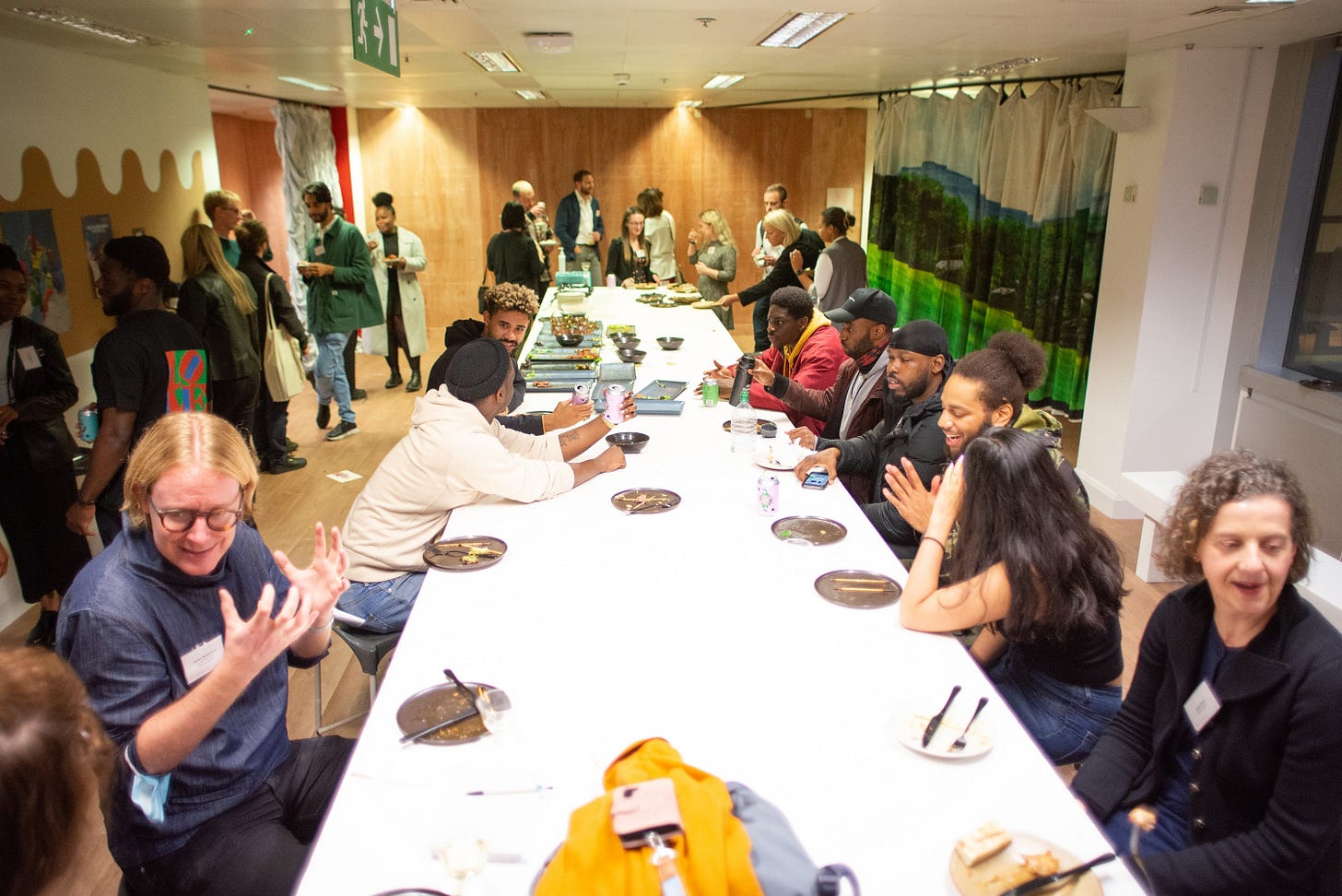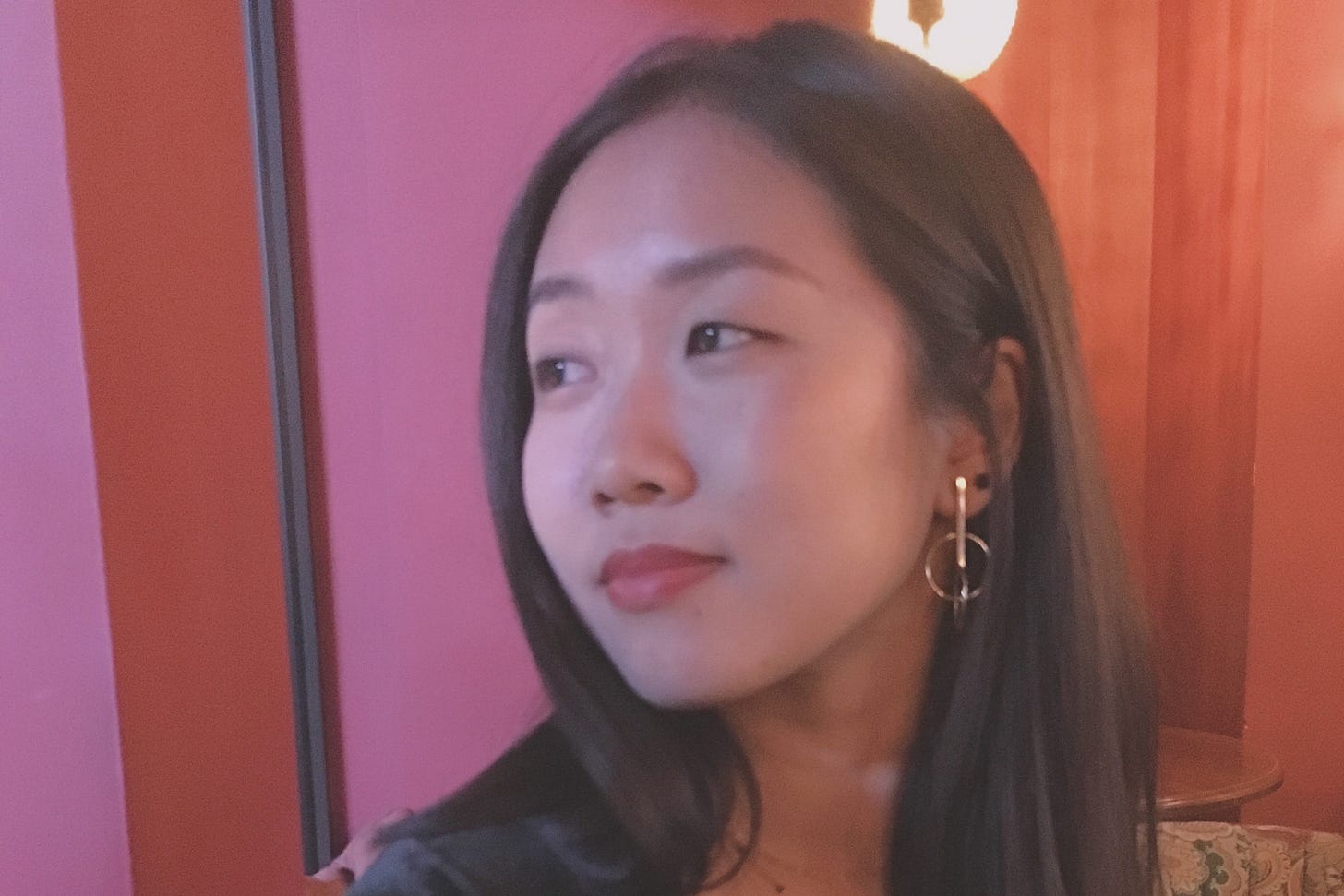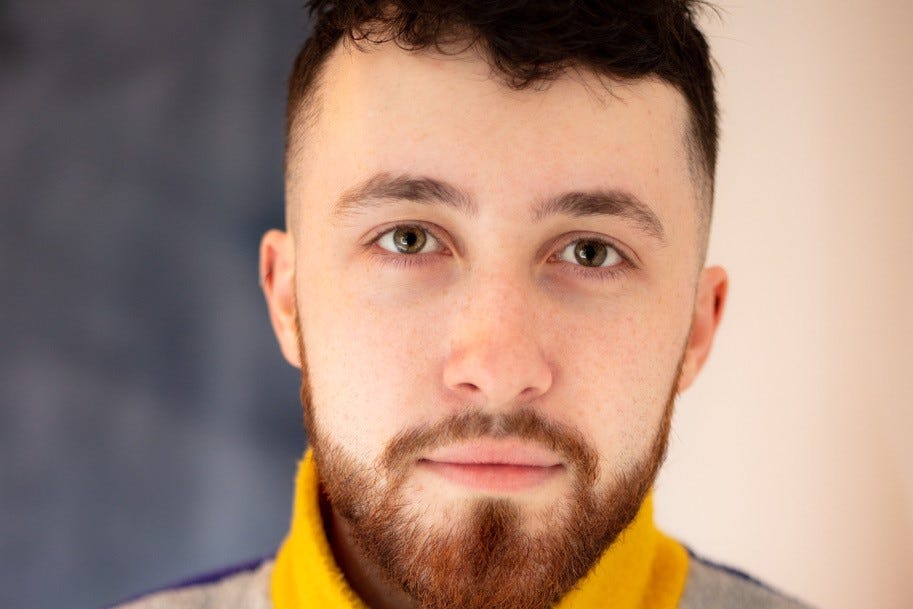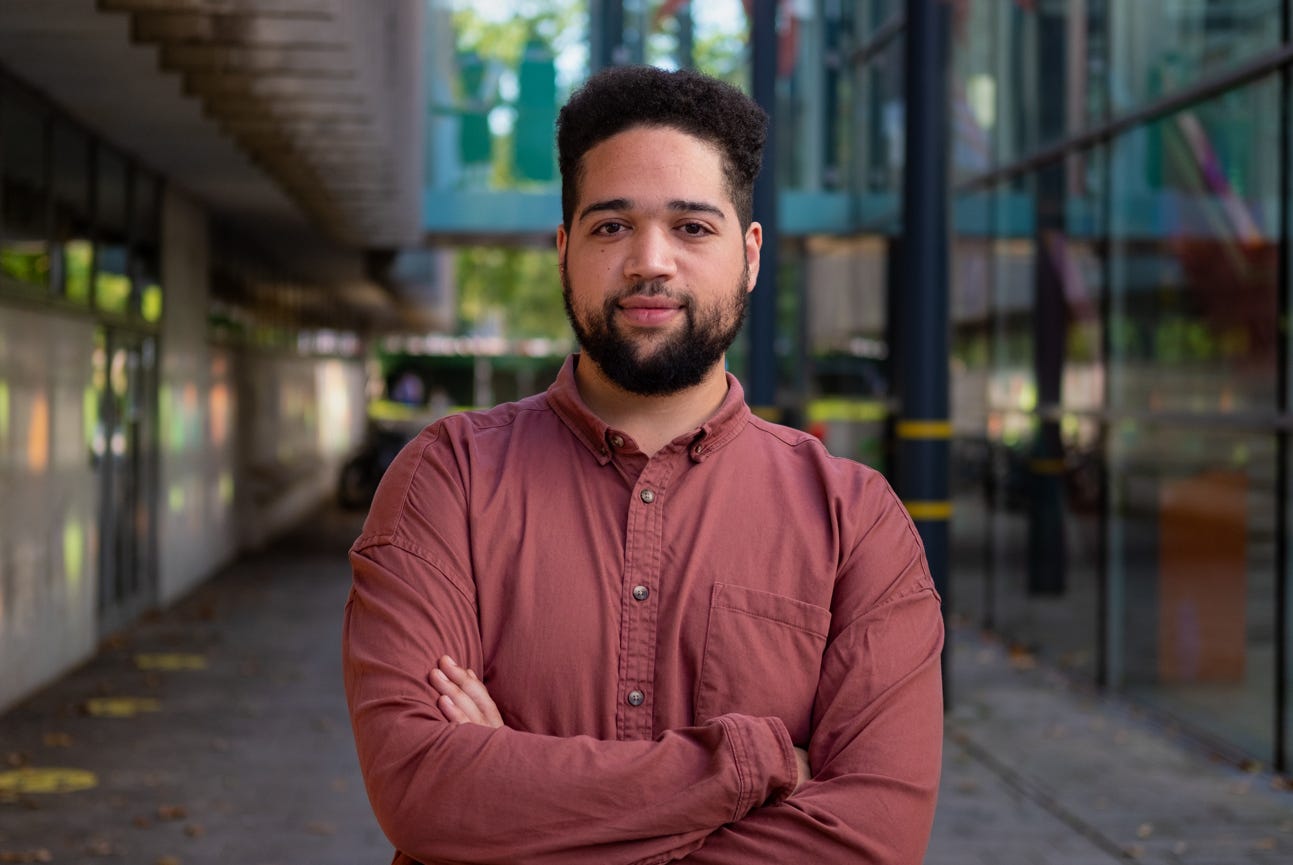NDT Broadgate is nurturing the next generation of designers.
Meet five of the ground-breaking facility's new resident theatremakers.
Hello, and welcome to The Crush Bar, a weekly newsletter about theatre written by me, Fergus Morgan.
Each issue usually features an interview with an exciting, emerging theatremaker - and gives them a chance to be explicit about where they want to go and what help they need to get there. Maybe you, reader, can give it to them, or put them in touch with someone who can.
This issue is a little bit different, though. Instead of one interviewee, there are five! They are all resident designers at NDT Broadgate’s design studio. Below, after an intro interview with NDT’s staff associate designer Shankho Chaudhuri, each of them explains more about their practice and where they want to take it.
You can read more about why I’m doing this here, and you can sign-up to get it delivered straight to your inbox using the button below…
A few months ago, this newsletter featured an exclusive interview with David Byrne, the artistic director of the New Diorama Theatre, on his company’s new, free-to-use, 20,000 square-foot facility in the City Of London.
Conceived by Byrne, facilitated by British Land, and designed by Joshua Gadsby and Naomi Kuyck-Cohen, NDT Broadgate includes 16 rehearsal rooms, 10 meeting rooms, and a design studio – 108,924 hours of creative space over the course of a year, with no fees and no catch.
Six months on, and the New Diorama Theatre’s staff associate designer Shankho Chaudhuri is overseeing an essential part of that engine – the sixth-floor design studio, where 20 early-career designers have recently been invited to take up year-long residencies, and a “design café” has just opened, where any freelance designer can drop in and work on an ad-hoc basis.
“There is a capacity for 60 in the design studio,” Chaudhuri explains. “Our 20 permanent resident designers can use the space whenever they want. Anyone else that wants to use it can sign up to our network and book a slot, any time between 10am and 6pm, Monday to Friday. Within that, there will always be five spaces reserved for those visiting from outside London.”
“This project’s real power is in bringing a lot of designers together to work alongside each other…”
Early-career designers rarely have the luxury of their own studios; at NDT Broadgate, they will have space specifically designed for them. No longer will they have to work from home, shifting model boxes from their desk to their bed to work, and back again to sleep. And that freedom to develop, and that ability to delineate between their professional and personal lives, is only one of the NDT Broadgate’s game-changing benefits, says Chaudhuri.
“Designers often work in isolation, but this project’s real power is in bringing a lot of designers together to work alongside each other,” he explains. “The dream is that the design studio, like the whole NDT Broadgate project, will be an engine-room for conversations that will ripple out across the industry. It will empower designers to go out and make changes.”
Set and costume designer Jasmine Swan has always been interested in telling stories visually.
For a while, she wanted to be a fine artist. “I did a lot of oil painting, and I even thought about studying art history at one point,” she says. “I ended up doing a foundation diploma in art and design at Kingston University, though, and that is where I discovered theatre design.”
That was in 2013. For the next three years, Swan studied theatre and performance design at LIPA, graduating in 2016. She was a finalist for the 2017 Linbury Prize, and spent the following few years modelmaking, assisting, and building a name for herself as a freelance designer, with credits including Shook at Southwark Playhouse, Armadillo at The Yard, and Eden at the Hampstead Theatre.
“First and foremost, I respond to the text, and to a conversation with the director, and my designs are entirely influenced by that,” Swan says. “Generally, though, I am drawn to non-naturalistic spaces. My designs are quite influenced by surrealist artists like Salvador Dali. I love creating work that is playful and imaginative, and embraces theatricality.”
Swan is currently working on The Watermill Theatre’s production of The Jungle Book, and is excited to be working with Les Enfants Terribles – “a company I’ve admired for a really long time,” she says – in 2022. Beyond that, she is keen to work on a bigger scale. “I would absolutely jump at the chance to do a show at the Royal Court, or the Almeida, or the Donmar Warehouse, or the Young Vic,” she says. “I’m also really interested in making spaces outside theatres. That could be immersive work, or it could be designing installations or exhibitions.”
Jasmine Swan is represented by Casarotto Ramsay & Associates.
Tingying Dong never thought she would become a sound designer, or a composer.
Born in Beijing, she initially studied behavioural economics – first in Tianjin, then in Rotterdam – before deciding to ditch that in favour of drama school when she arrived in the UK in 2016. She studied at LAMDA for three years and emerged with a first-class BA in Production and Technical Arts in 2019, having specialised in sound design.
“I was quite musical growing up,” Dong says. “I learned to play the piano when I was little. I did ballet for ten years. I was always in student choirs. But it was at LAMDA that I discovered sound design. Then I started creating my own soundscapes as part of my designs, and my composing grew out of that.”
Since graduating, Dong has worked on dozens of projects, as both a sound designer and a composer, including Hannah Kumari’s ENG-ER-LAND, Polly Creed’s Humane, (alongside last week’s interviewee Imy Wyatt Corner), and Imaginarium, the multi-lingual, experimental audio show she co-created as a founder member of Out Of The Blue Theatre. She responds to every project differently, she says, but is most interested in “creating abstract soundscapes” that “build atmosphere” and “reflect the world of the characters.”
In 2022, Dong is going to be sound designing two shows at Hampstead Theatre – Alan Plater’s Peggy For You and Nell Leyshon’s Folk – but her ultimate aim is to work in a devising capacity. “As a sound designer, you often have to work on multiple shows at once, going between different rehearsal rooms, and that frustrates me,” she says. “I’d love to be more embedded in a creative process. I’d love to develop a show with a company like Complicité.”
Tingying Dong is represented by United Agents.
Birmingham-born lighting and set designer Andrew Exeter likes to use bright, bold colours.
“As a teenager, I went to BOA academy and did a technical course,” he says of his start in theatre. “I was DSM-ing one show, and kept complaining to my tutor that I really didn’t like the lighting I had to operate. He suggested I should study lighting design. I did, and I loved it.”
Exeter subsequently spent three years studying lighting design at Rose Bruford College. He started working professionally while still a student, as an assistant then associate of lighting designer Ben Cracknell on commercial shows like Rock of Ages, Priscilla Queen of the Desert, Heathers, and the upcoming West End jukebox musical The Drifters Girl.
Since graduating in 2020, Exeter has found his own freelance work, too – and not just as a lighting designer. He designed the set for Lady Chatterley’s Lover in the West End and The Last Five Years at Cornwall’s Minack Theatre. “I’m quite influenced by pop artists like Warhol and Basquiat, and by light artists like James Turrell,” Exeter says. “I like using really bold colours, whether that’s as a lighting designer, or a set designer.”
Exeter’s slightly unusual route into the industry has left some gaps in his career that he is eager to fill. “I love working commercially, but you rarely get the luxury of time,” he says. “I would really like to start working in the subsidised sector, where I can get involved in a long creative process. I think I would find that really satisfying.”
Performance designer Blythe Brett “was always in a dream world” growing up.
“I was always making things and playing around with objects,” she says. “Then, when I was 16, the director of a youth theatre group I was in suggested I had a go at designing one of our shows. I loved it, particularly the combination of having a degree of autonomy, while still working collaboratively. I’ve been doing it ever since.”
Brett studied for a year at The Royal Drawing School, took a gap year, then spent three more years studying performance design at the Royal Welsh College of Music and Drama, graduating in 2020. It was “scary”, she says, suddenly entering the industry in the middle of lockdown, “but you just have to have the gumption to go out and find work anyway.”
Over the past year, Brett has been working on a few freelance projects with English Touring Opera and Breach Theatre, as well as assisting the designer Vicki Mortimer on Bach & Sons at the Bridge Theatre, Wuthering Heights at the Old Vic, and the upcoming Our Generation at the National Theatre. She is also assisting the designer Rhys Jarman on new shows from Gecko Theatre and Police Cops – “two very different experiences,” she laughs.
Brett is reluctant to put limitations or labels on her practice – it is the reason she calls herself a performance designer, instead of a set and costume designer – this early in her career. She is still finding her feet, she says, but one of the things she is interested in exploring is collaborating with other designers to create a show that is design-led, as opposed to text-led or direction-led. That, she says, “would be super exciting.”
Simeon Miller has done a bit of everything over the last decade – stage management, production management, technical management, even candle consultancy at the Sam Wanamaker Playhouse.
He worked backstage with a youth theatre group as a teenager and, unsure what he wanted to do after leaving school, fell into it professionally in his early twenties, taking on “any role people would pay me to do.”
He found lighting design “almost by a process of elimination”, and subsequently spent three years studying it at Mountview Academy, graduating in 2010. Since then, he has still juggled various roles, including that of creative director at events company Eventide – “I like the idea of being a jack-of-all-trades,” he says – but worked predominantly as a lighting designer in London’s fringe theatres.
“I approach lighting design like it is a puzzle that needs to be solved,” Miller says. “A show has all these different elements – the set, the costumes, the performers – and I think my job as a lighting designer is to fit all those jigsaw pieces into place, to find the ideal combination of lights that brings everything together on stage.”
Miller recently worked on Milk and Gall at Theatre503, and is about to head to Reading Rep to work on its production of A Christmas Carol. “I’m not particularly interested in working on revivals,” he says. “I’m much more interested on new projects that are socially progressive and will have an impact on the world. At the moment, I’m trying to work out if I can get an agent, and still pursue the projects that I want to work on.”
The Crush Bar is totally free and unfunded at present, so anything you can do to support it is hugely appreciated. There are three helpful things in particular: you can subscribe using the button above, you can share it, either on social media or by forwarding it to anyone who might be interested, and you can donate to my Ko-Fi account using the button below.
If you want to get in touch with me to ask about anything, or to suggest someone who deserves a shout-out in this newsletter, you can reach me on Twitter - I’m @FergusMorgan - or by simply replying to this email. That’s all for now. Back in a week. Thanks for reading.
Fergus Morgan








